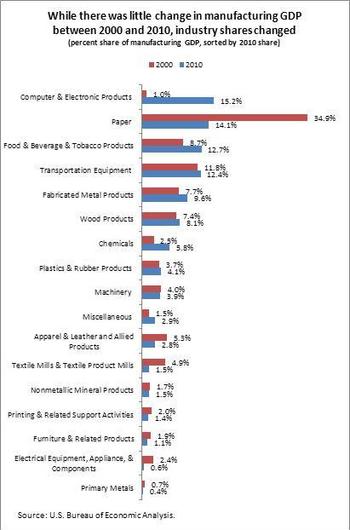|
Report on Manufacturing Job Trends and Outlook Released

Manufacturing jobs have been declining in Maine for the last 30 years. Much of the job loss was concentrated in a few industries, primarily the shoe shops and textile mills that built many of our cities, and the forest products industries that were at the heart of the economy in much of the northern part of the state. A new report, Manufacturing Jobs: Trends, Issues, and Outlook, focuses on more recent trends in employment and output in the sector since 2000. It finds that:
- Productivity gains have allowed manufacturers to maintain output at about the same level, despite the loss of 29,000 jobs since 2000.
- The largest job losses and the largest decline in the share of manufacturing output occurred among paper mills.
- Chemicals and beverage & tobacco products were the only manufacturing industries with net job growth; the other 15 industries experienced job losses.
- Output increased in 10 of the 17 industries, with the largest gains in computer & electronic products.
The report also notes that despite relatively high unemployment and the large numbers of displaced former production workers, large numbers of production jobs remain unfilled. The primary reason is that the manufacturers that have survived and are thriving are those that invested heavily in capital-intensive production systems that tend to have much higher performance requirements than what many of the former production workers possess in terms of education and experience. A successful future for manufacturing will depend, in part, on how well we bridge the divide between the talent employers need and job seekers offer.
The report is available here on the CWRI Publications webpage.
This Month's Articles of Interest:
The Benefits of Manufacturing Jobs (HTML)
(PDF)
The role
of the manufacturing sector in the U.S. economy is more prominent than is
suggested solely by its output or number of workers. A recent report by the
U.S. Economics and Statistics Administration notes it is a cornerstone of
innovation in our economy: manufacturing firms fund most domestic corporate
R&D, and the resulting innovations and productivity growth improve our
standard of living. Manufacturing also drives U.S. exports and is crucial for a
strong national defense. Manufacturing jobs are often cited as “good jobs”: they pay well, provide good
benefits, and workers are less likely to quit than in other private sectors.
Hard Times: Not All College Degrees Are Created Equal (HTML) (PDF)
Much attention has been devoted to high unemployment among recent college
graduates, leading some to conclude that college is no longer worth it. A
recent study by the Center on Education and the Workforce found college remains
the best alternative for young workers, though not all majors are equal. The
authors found that some majors offer
substantially better employment and earning prospects than others, people who make technology are better off than
people who use technology and majors linked to occupations have better
employment prospects than majors focused on general skills.
Recent Economic Releases
|